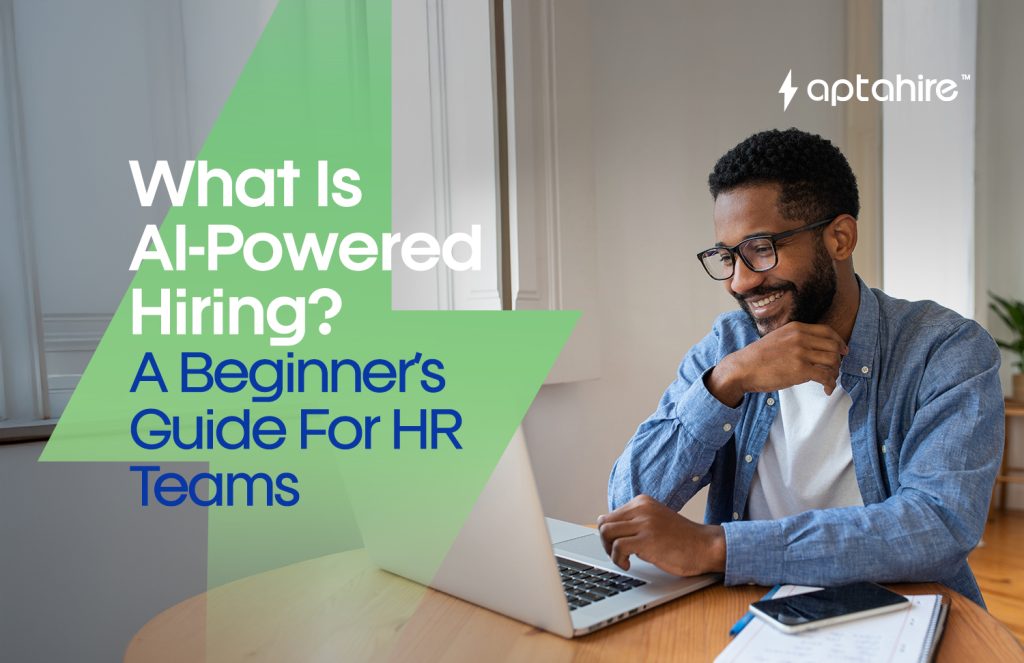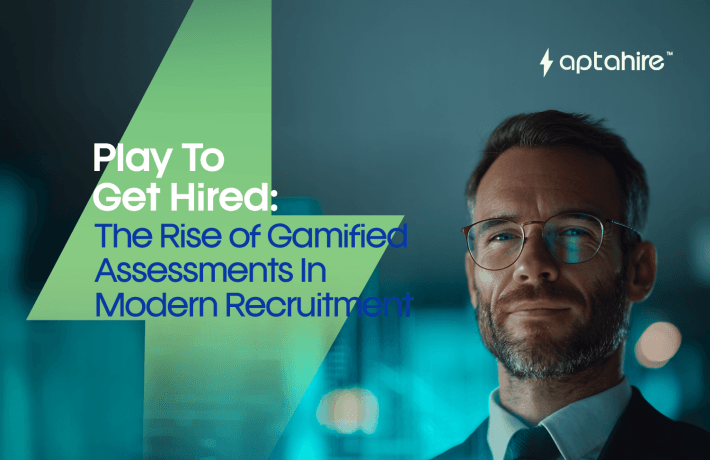What is AI-Powered Hiring? A Beginner’s Guide for HR Teams

Hiring the right candidate has always been a blend of art and science. But as the world of work evolves, fueled by technology, remote culture, and changing workforce expectations, traditional hiring methods are starting to show their cracks. Endless resume piles, unconscious bias, delayed follow-ups, and inconsistent evaluations make the recruitment process frustrating, for both recruiters and candidates.
Now imagine a world where the right candidates come to you, job descriptions write themselves, and interviews get scored objectively. Welcome to the world of AI-powered hiring.
In this blog, we’ll break down what AI hiring really means, how it works, where it’s being used, and how you, as an HR team, can start using it, without needing a Ph.D. in data science.
What is AI-Powered Hiring?
AI-powered hiring refers to the use of Artificial Intelligence technologies, like machine learning, natural language processing, and computer vision, to automate and enhance various stages of the recruitment process.
It goes beyond applicant tracking. AI actively assists in:
- Writing inclusive job descriptions
- Finding and shortlisting the best candidates
- Screening resumes at scale
- Analyzing candidate behavior during interviews
- Predicting job performance and attrition
- Reducing bias in hiring decisions
Rather than replacing human recruiters, AI acts as a co-pilot, doing the heavy lifting in repetitive or data-heavy tasks so recruiters can focus on the human side of hiring.
How Does AI Fit into the Hiring Process?
Let’s walk step-by-step through the hiring funnel and see where AI adds value.
1. Creating Job Descriptions
AI writing assistants help HR teams write job posts that are:
- Gender-neutral
- Free of jargon
- More likely to rank in job searches
For example, a tool like Textio flags language that may be unintentionally biased or limiting, helping you attract more diverse applicants.
2. Talent Sourcing and Outreach
AI-powered sourcing tools like HireEZ, SeekOut, or LinkedIn Recruiter AI scan through millions of online profiles and resumes across platforms to:
- Match candidates to job criteria
- Rank them by relevance
- Predict response rates
Many even generate personalized messages and automate outreach, saving hours of manual effort.
3. Resume Screening and Shortlisting
This is where most HR teams spend the bulk of their time.
With AI, you can automatically:
- Parse resumes and extract relevant information
- Match candidate experience with job requirements
- Rank candidates based on scoring models
Tools like AptaHire, HireVue, and Manatal do this at scale. Imagine cutting down 500 resumes to a shortlist of 20 in seconds, objectively and fairly.
4. Candidate Engagement with Chatbots
AI chatbots serve as virtual recruiters, engaging with candidates on your career site or over WhatsApp. They can:
- Answer FAQs about the role or company
- Schedule interviews
- Collect pre-screening responses
- Send reminders and updates
This improves the candidate experience while freeing up your team from repetitive communication.
5. Video Interviews + Behavioral Analysis
Tools like HireVue, myInterview, or AptaHire use AI to:
- Analyze tone, facial expressions, word choice, and eye movement
- Evaluate soft skills like confidence, emotional intelligence, and communication
While the final hiring decision remains human, AI helps highlight traits that might be missed in manual reviews.
6. Skill, Cognitive, and Personality Assessments
AI-based gamified tests or behavioral assessments can analyze:
- Problem-solving abilities
- Attention to detail
- Culture fit
- Learning agility
For instance, Pymetrics uses neuroscience-based games to match people’s cognitive and emotional traits with role requirements.
7. Predictive Hiring Analytics
AI hiring tools go one step ahead by helping you forecast outcomes:
- Will this candidate accept the offer?
- Will they stay for more than a year?
- How well will they perform in 90 days?
These insights allow HR teams to proactively plan onboarding, succession, and retention.
Why HR Teams Are Embracing AI Hiring
Here’s why AI-powered hiring isn’t just a trend, it’s becoming an industry standard.
1. Speed
Manual processes slow things down. AI tools work 24/7, never take breaks, and screen thousands of resumes in seconds.
Result? Reduced time-to-hire by up to 50%.
2. Consistency and Fairness
Human evaluations are influenced by mood, fatigue, and unconscious bias. AI applies the same criteria to every candidate, making evaluations consistent.
3. Cost Efficiency
Hiring the wrong candidate can cost up to 30% of their annual salary. AI reduces costly mis-hires by improving quality-of-hire.
4. Better Candidate Experience
AI chatbots ensure no candidate feels ghosted. Smart assessments make the process interactive and engaging.
5. Data-Backed Hiring Decisions
Instead of going with gut instincts, HR teams now get access to deep insights, personality profiles, job-fit scores, and attrition risk, all backed by data.
Real-World Case Studies
Unilever’s AI Hiring Success
Unilever replaced CV reviews and initial phone interviews with AI assessments and video interviews using HireVue and Pymetrics.
Results:
- 90% time saved in initial screening
- Hiring from over 250% more diverse talent pools
- Increased candidate satisfaction
L’Oréal Uses AI for High-Volume Recruitment
During campus drives, L’Oréal uses AI to screen and interview thousands of students simultaneously—cutting down months of work into weeks.
AptaHire in Action
A mid-sized Indian tech company using AptaHire reported:
- 63% drop in screening time
- 2x increase in qualified candidates shortlisted
- 46% increase in interview-to-offer conversion
Challenges of AI in Hiring
While AI is powerful, it comes with its own learning curve and responsibility.
Bias in Algorithms
If historical hiring practices were biased (e.g., favoring male candidates), AI might replicate them.
Tip: Ask your vendor how their models are trained and audited for fairness.
Lack of Human Touch
Over-relying on automation may alienate candidates or overlook important human cues.
Tip: Blend AI with human interviews and empathetic communication.
Learning Curve for HR Teams
HR professionals may feel overwhelmed by new tools and dashboards.
Tip: Start with user-friendly platforms and invest in training.
How to Get Started with AI Hiring (Step-by-Step)
You don’t need to go “full AI” on Day 1. Here’s a practical roadmap:
Step 1: Identify Your Pain Points
- Are you swamped with resumes?
- Struggling to source candidates?
- Experiencing high drop-off rates?
Pinpoint where AI can bring immediate value.
Step 2: Choose the Right Tool
Pick one or two tools to pilot. For example:
- Resume screening tool (e.g., AptaHire)
- Interview scheduling chatbot (e.g., Paradox)
- Video interview analyzer (e.g., HireVue)
Step 3: Train Your Team
Invest in workshops or tutorials to help your team understand the tool and interpret the insights correctly.
Step 4: Test and Tweak
Run small hiring batches using AI, compare outcomes, and collect feedback from candidates and hiring managers.
Step 5: Scale Across Hiring Processes
Once confident, expand to other functions like onboarding, workforce planning, and performance tracking.
Final Thoughts: The Future is AI-Augmented, Not AI-Replaced
AI-powered hiring is not about replacing recruiters; it’s about making them superhuman.
It removes grunt work. It gives you better candidates. It makes your hiring faster, fairer, and more strategic.
But just like any tool, it’s only as good as the hands that wield it. The best results come when HR teams blend the precision of AI with the empathy of human judgment.
So, whether you’re a 5-member HR team or a global talent acquisition powerhouse, now is the time to rethink your recruitment process, and let AI help you find the right people to power your mission.
Ready to Begin?
Start small. Stay ethical. Stay human. And let AI help you unlock your best hires yet.
FAQs
1. What is AI-powered recruitment?
AI-powered recruitment uses artificial intelligence to automate and improve hiring tasks like resume screening, candidate matching, and interview analysis.
2. How can AI be used in hiring?
AI helps write job descriptions, source candidates, screen resumes, schedule interviews, analyze video interviews, and predict job performance.
3. What is an example of AI bias in hiring?
Amazon’s AI tool showed bias by downgrading resumes that mentioned “women’s” because it was trained on biased historical data.
4. Which AI tool is best for recruitment?
Popular tools include AptaHire for interview analysis, HireVue for video interviews, and Pymetrics for soft skills assessments.
5. What is AI-powered?
“AI-powered” means a process or tool that uses artificial intelligence to function smarter, faster, and more efficiently.
6. What is the future of AI in recruitment?
AI will continue to make hiring faster, more data-driven, and fairer, while helping HR teams focus on strategy and candidate experience.
7. How is AI used in HR?
AI is used in HR for hiring, onboarding, employee engagement, performance tracking, and predicting attrition or training needs.



